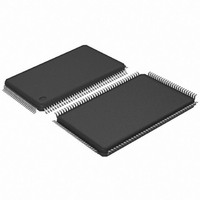AT91SAM7L64-AU Atmel, AT91SAM7L64-AU Datasheet - Page 70

AT91SAM7L64-AU
Manufacturer Part Number
AT91SAM7L64-AU
Description
MCU ARM7 64K HS FLASH 128-LQFP
Manufacturer
Atmel
Series
AT91SAMr
Specifications of AT91SAM7L64-AU
Core Processor
ARM7
Core Size
16/32-Bit
Speed
36MHz
Connectivity
I²C, SPI, UART/USART
Peripherals
Brown-out Detect/Reset, LCD, POR, PWM, WDT
Number Of I /o
80
Program Memory Size
64KB (64K x 8)
Program Memory Type
FLASH
Ram Size
6K x 8
Voltage - Supply (vcc/vdd)
1.55 V ~ 1.8 V
Data Converters
A/D 4x10b
Oscillator Type
Internal
Operating Temperature
-40°C ~ 85°C
Package / Case
128-LQFP
Controller Family/series
AT91SAM7xxx
No. Of I/o's
80
Ram Memory Size
6KB
Cpu Speed
36MHz
No. Of Timers
1
Rohs Compliant
Yes
Processor Series
AT91SAMx
Core
ARM7TDMI
Data Bus Width
32 bit
Data Ram Size
6 KB
Interface Type
2-Wire, SPI, USART
Maximum Clock Frequency
36 MHz
Number Of Programmable I/os
80
Number Of Timers
3
Maximum Operating Temperature
+ 85 C
Mounting Style
SMD/SMT
3rd Party Development Tools
JTRACE-ARM-2M, MDK-ARM, RL-ARM, ULINK2
Development Tools By Supplier
AT91SAM-ICE, AT91-ISP, AT91SAM7L-EK
Minimum Operating Temperature
- 40 C
On-chip Adc
10 bit, 4 Channel
For Use With
AT91SAM7L-STK - KIT EVAL FOR AT91SAM7LAT91SAM-ICE - EMULATOR FOR AT91 ARM7/ARM9
Lead Free Status / RoHS Status
Lead free / RoHS Compliant
Eeprom Size
-
Lead Free Status / Rohs Status
Details
Available stocks
Company
Part Number
Manufacturer
Quantity
Price
- Current page: 70 of 564
- Download datasheet (9Mb)
14.4
14.4.1
14.4.2
14.4.3
14.4.4
70
Functional Description
AT91SAM7L128/64 Preliminary
Reference Clock
Timing
Alarm
Error Checking
The RTC provides a full binary-coded decimal (BCD) clock that includes century (19/20), year
(with leap years), month, date, day, hours, minutes and seconds.
The valid year range is 1900 to 2099, a two-hundred-year Gregorian calendar achieving full Y2K
compliance.
The RTC can operate in 24-hour mode or in 12-hour mode with an AM/PM indicator.
Corrections for leap years are included (all years divisible by 4 being leap years, including year
2000). This is correct up to the year 2099.
After hardware reset, the calendar is initialized to Thursday, January 1, 1998.
The reference clock is Slow Clock (SLCK). It can be driven by the Atmel cell OSC55 or OSC56
(or an equivalent cell) and an external 32.768 kHz crystal.
During low power modes of the processor (idle mode), the oscillator runs and power consump-
tion is critical. The crystal selection has to take into account the current consumption for power
saving and the frequency drift due to temperature effect on the circuit for time accuracy.
The RTC is updated in real time at one-second intervals in normal mode for the counters of sec-
onds, at one-minute intervals for the counter of minutes and so on.
Due to the asynchronous operation of the RTC with respect to the rest of the chip, to be certain
that the value read in the RTC registers (century, year, month, date, day, hours, minutes, sec-
onds) are valid and stable, it is necessary to read these registers twice. If the data is the same
both times, then it is valid. Therefore, a minimum of two and a maximum of three accesses are
required.
The RTC has five programmable fields: month, date, hours, minutes and seconds.
Each of these fields can be enabled or disabled to match the alarm condition:
Depending on the combination of fields enabled, a large number of possibilities are available to
the user ranging from minutes to 365/366 days.
Verification on user interface data is performed when accessing the century, year, month, date,
day, hours, minutes, seconds and alarms. A check is performed on illegal BCD entries such as
illegal date of the month with regard to the year and century configured.
If one of the time fields is not correct, the data is not loaded into the register/counter and a flag is
set in the validity register. The user can not reset this flag. It is reset as soon as an acceptable
value is programmed. This avoids any further side effects in the hardware. The same procedure
is done for the alarm.
The following checks are performed:
• If all the fields are enabled, an alarm flag is generated (the corresponding flag is asserted
• If only the “seconds” field is enabled, then an alarm is generated every minute.
and an interrupt generated if enabled) at a given month, date, hour/minute/second.
6257A–ATARM–20-Feb-08
Related parts for AT91SAM7L64-AU
Image
Part Number
Description
Manufacturer
Datasheet
Request
R

Part Number:
Description:
KIT EVAL FOR AT91SAM7L
Manufacturer:
Atmel
Datasheet:

Part Number:
Description:
DEV KIT FOR AVR/AVR32
Manufacturer:
Atmel
Datasheet:

Part Number:
Description:
INTERVAL AND WIPE/WASH WIPER CONTROL IC WITH DELAY
Manufacturer:
ATMEL Corporation
Datasheet:

Part Number:
Description:
Low-Voltage Voice-Switched IC for Hands-Free Operation
Manufacturer:
ATMEL Corporation
Datasheet:

Part Number:
Description:
MONOLITHIC INTEGRATED FEATUREPHONE CIRCUIT
Manufacturer:
ATMEL Corporation
Datasheet:

Part Number:
Description:
AM-FM Receiver IC U4255BM-M
Manufacturer:
ATMEL Corporation
Datasheet:

Part Number:
Description:
Monolithic Integrated Feature Phone Circuit
Manufacturer:
ATMEL Corporation
Datasheet:

Part Number:
Description:
Multistandard Video-IF and Quasi Parallel Sound Processing
Manufacturer:
ATMEL Corporation
Datasheet:

Part Number:
Description:
High-performance EE PLD
Manufacturer:
ATMEL Corporation
Datasheet:

Part Number:
Description:
8-bit Flash Microcontroller
Manufacturer:
ATMEL Corporation
Datasheet:

Part Number:
Description:
2-Wire Serial EEPROM
Manufacturer:
ATMEL Corporation
Datasheet:











